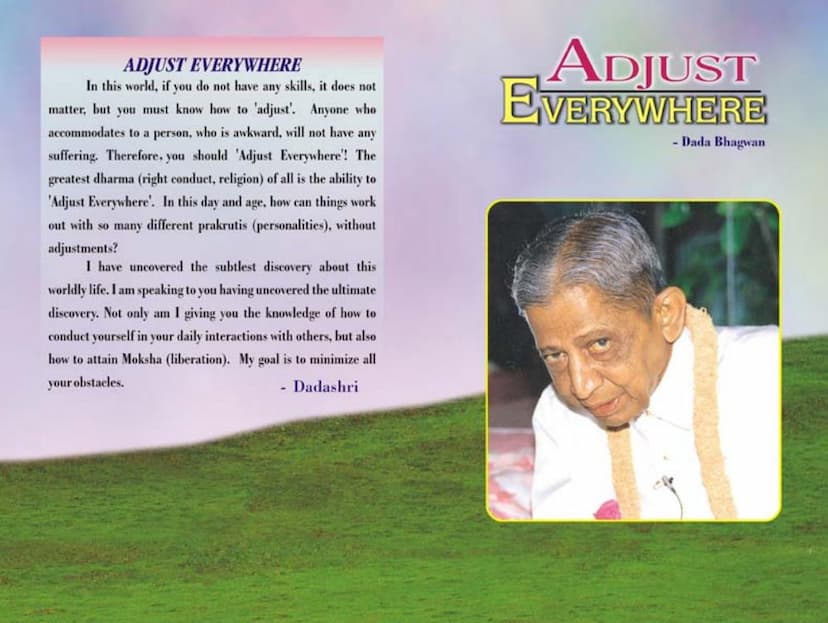Adjust Everywhere
Added to library: September 1, 2025

Summary
This document is a summary and excerpt from the Jain text "Adjust Everywhere" by Dada Bhagwan. The core philosophy presented is that the ability to adjust with everyone and in every situation is the greatest dharma and the key to achieving peace, happiness, and ultimately, liberation (Moksha).
Here's a breakdown of the key themes and teachings:
The Central Message: "Adjust Everywhere"
- The Ultimate Skill: The book emphasizes that knowing how to "adjust" is more important than having worldly skills. This ability prevents suffering and helps navigate life's complexities.
- Universal Application: The advice is to "adjust everywhere," meaning with every person, in every situation, regardless of whether you like them or agree with them.
- Preventing Suffering: Adjusting is presented as the direct antidote to suffering. By accommodating others and their different "prakrutis" (personalities/natures), one avoids pain and conflict.
- The Highest Religion: The ability to adjust with everyone is declared to be the greatest dharma or religion.
The Teachings of Dadashri (Ambalal M. Patel)
- Self-Realization: The book introduces Ambalal M. Patel, known as Dadashri or Dada Bhagwan, who experienced spontaneous Self-Realization in 1958. He described this experience as the melting of his ego and the full manifestation of "Dada Bhagwan" (the Lord within) within him.
- Akram Vignan: Dadashri's teachings are based on "Akram Vignan" or the "Step-less Science," a direct and rapid path to Self-Realization. This path is achieved through a scientific process called the "Gnan Vidhi," which can impart knowledge of the Self in a short time.
- The "Dada Bhagwan" Within: Dadashri clarified that "Dada Bhagwan" is the divine Lord residing within all living beings, fully manifested within him. He emphasized that he was not God himself but an instrument through whom this divine consciousness worked.
- Practical Wisdom: Dadashri's teachings are rooted in practical, worldly interactions, aiming to minimize obstacles and guide people towards liberation.
Key Principles and Examples of Adjustment:
- Understanding Differences: The world is filled with diverse "prakrutis" (personalities, tendencies, natures). Just as different flowers have different colors and fragrances in a garden, people have different natures. Recognizing and accepting these differences is crucial for adjustment.
- Not Interfering, Just Adjusting: The advice is to avoid interfering with others' ways, especially when times change. For example, an elder should adjust to new trends adopted by younger generations rather than criticizing them.
- Adjusting to Disagreeable People: Negative and disagreeable people are likened to sewers, which can smell unpleasant. The teaching is to adjust to both pleasant (flowers) and unpleasant (sewers) encounters.
- Avoiding Clashes: Conflicts arise from differing opinions and viewpoints. Instead of insisting on one's own viewpoint, one should adjust. If someone calls you foolish, you should agree and say, "You are right." This prevents further conflict.
- Marital Adjustments: The book offers specific advice for marital harmony, emphasizing mutual adjustment. If the wife cooks one thing and the husband desires another, instead of quarreling, one should adjust to the other's convenience. The principle is: whoever suggests something first, the other adjusts.
- "Eat Khichari or Eat Pizza": This analogy illustrates that if you insist on your preference (gulabjamoons) and it leads to a quarrel, you might end up with neither your preference nor an acceptable alternative (khichari), possibly only getting a compromise like pizza. It's better to adjust initially.
- "To Improve Her or To Adjust to Her": The book strongly advises against trying to "improve" or change your spouse. You cannot change another's inherent nature. Accepting them as they are and adjusting is the path to peace.
- "Wife is a Counterweight": A wife is described as a counterweight that stabilizes a man. Without this balance, a man might become aimless.
- "Do Not See the Laws, Just Settle": In difficult times, the focus should be on settling matters rather than adhering strictly to rules or seeking justice. Consider others' hundreds of mistakes as your own and move on.
- Adjusting to Different "Revolutions": "Revolutions" refers to the speed of a person's thinking. To communicate effectively and avoid clashes, one must use a "counter-pulley" to slow down their own "revolutions" to match the other person's level. This is the science of adjusting.
- Fault Lies with the Adjuster: When conflicts arise, the person who knows how to adjust is considered to be in the right. Adjusting is seen as the solution, and misadjustment is considered foolishness.
- Ignorance as the Root Cause: Conflicts stem from ignorance, particularly ignorance of the true nature of the Self and the world. Once Self-knowledge is attained, the path becomes clear: "Adjust Everywhere."
- Respecting Offerings: Even if presented with something you don't like, such as food, it's important to respect the intention and the offering. This is a form of adjustment.
- The Goal is Peace: The ultimate intention and goal behind adjustment is peace. It is the key to avoiding unhappiness.
The Book's Structure and Context:
- The book is presented as a compilation of Dadashri's discourses (satsangs) and question-and-answer sessions.
- The publisher is the Dada Bhagwan Foundation.
- A note clarifies that the English translation aims to convey the essence and tone of Dadashri's teachings, acknowledging that some depth might be lost.
- The document also includes a list of other books by Dadashri and contact information for further guidance and spiritual seekers.
In essence, "Adjust Everywhere" is a practical guide to living a harmonious and peaceful life, both within oneself and in relation to the world. It advocates for a proactive approach of understanding, acceptance, and flexibility as the ultimate solution to life's challenges, leading ultimately to spiritual liberation.